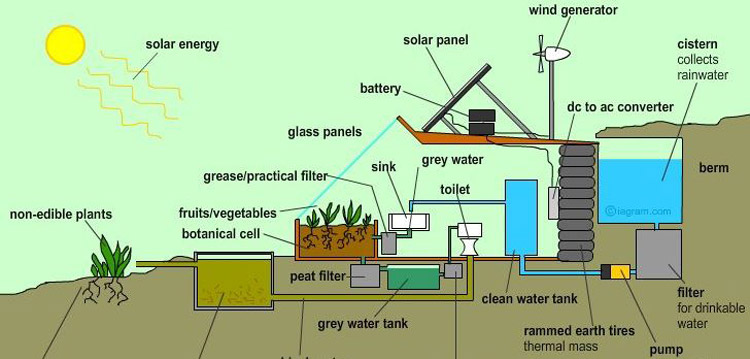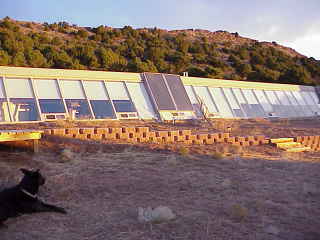earthship

Earthship plan.
An earthship is a passive solar building with thermal mass. Made from natural and recycled materials, including earth-rammed tires and aluminum cans. it is powered by renewable energy, such as wind, water and solar power, catches its own water supply from rainwater, and treats and contains its own sewage in planter beds. The earthship is a concept, not a set design, and can be adapted for any climate worldwide. It offers people the opportunity to build their own homes and make a conscious decision to live lightly on the earth.
 |
| Earthship in Colorado
|
Built to utilize available local resources – for example, by having windows on the sunny side to admit a maximum amount of light and heat – its construction is often horseshoe-shaped to also maximize natural light and solar-gain during winter months. Likewise, the thick, dense outer walls provide effective insulation against summer heat. Internal, non-load-bearing walls are often made of a honeycomb of recycled cans joined by concrete and are referred to as tin can walls. These walls are usually thickly plastered with stucco. Adding to the energy efficiency of the earthship is a heavily insulated roof.
A defining feature of an earthship is that it is completely off-grid and self-sufficient: it provides food from integrated greenhouses, water from the roof, graywater recycling, electricity from wind turbines and solar panels and passive solar methods of heating and cooling. The term "earthship", coined by self-proclaimed 'biotect' Mike Reynolds, derives from the fact that these homes as being in and of the Earth, i.e., constructed responsibly out of earthen or recycled materials and built into the ground. It also refers to life in one of these homes being like that aboard ship, in which the crew must be able to function independently of outside help, such as connection to a power grid.
The concept has spread beyond its roots in the desert surrounding Taos, New Mexico. Earthships can be found today in most US states, though the greatest concentration is still in New Mexico, followed closely by Colorado. Several have sprung up in England and France as well as in South Africa, among other countries.
